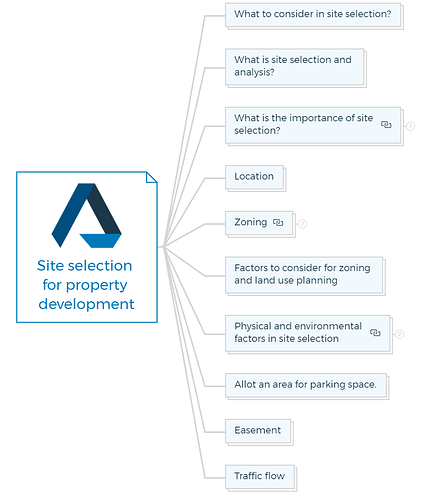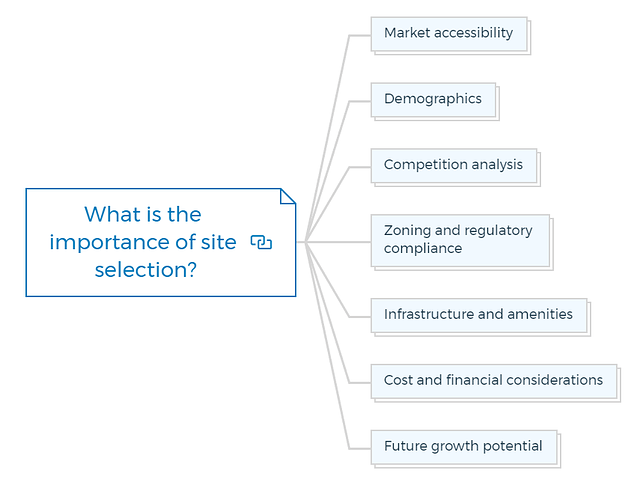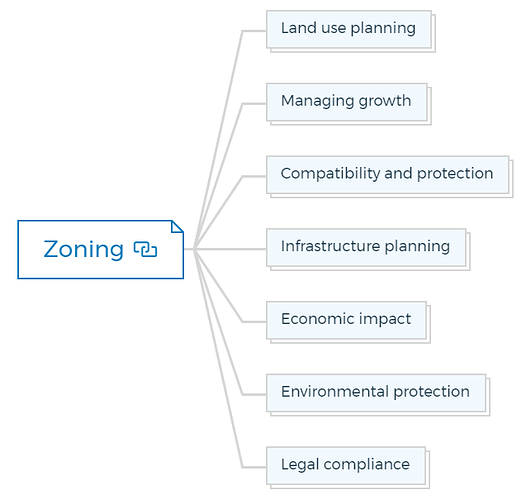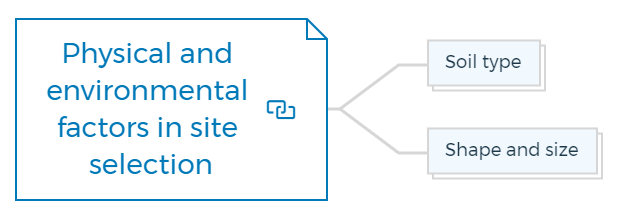Site Selection
A typical site selection calls for several factors that we will be discussing in detail, as well as multiple steps to help you find the best possible site for the best use.
What to consider in site selection?
Rather than randomly opting for a site and moving in, a real estate investor should and must shop around a little.
- Carefully analyse the market and choose a location that aligns with your business objectives.
- Consider the surrounding factors, such as demographics, neighbourhood status, and scenic views.
- Evaluate the availability of resources and utilities like electricity, water, drainage, gas, sewer, and telephone.
- Consider the proximity to transportation facilities, freeways, warehouses, and other relevant amenities.
- Assess the zoning code and understand the regulations that apply to the site.
- Investigate land ownership to ensure clear title and ownership rights.
- Consider any conditional use permits or zoning variances that may be required for your intended use.
Some of the considerations that you need to bear in mind when it comes to finding the right property for your investment include:
- Location
- Zoning
- Physical characteristics
- Parking
- Setbacks
- Easements
- Traffic flow
- Site Access and Egress
- Council/Developers’ contribution
You are missing out if you haven’t yet subscribed to our YouTube channel.
What is site selection and analysis?
Site selection is a significant highlight of the whole due diligence process as it lays the foundation of your business.
Site selection and analysis is a process of evaluating potential locations for a specific purpose, such as setting up a business or developing a property.
This process includes an assessment of the search area assignment through zoning code and land ownership investigation.
The goal is to make informed decisions based on thorough research and analysis to maximise the chances of success and long-term value creation.
What is the importance of site selection?
Site selection can make or break a business or development endeavour. Site selection matters for several reasons:
Market accessibility
The correct location may make target customers, suppliers, and partners easily accessible. It helps companies reach their target market and develop.
Demographics
Knowing an area’s demographics helps firms cater to their target customers’ demands. Site selection helps companies find demographically suitable locations.
Competition analysis
Assessing local competition helps businesses evaluate market demand and success. It helps companies differentiate themselves from the competition.
Zoning and regulatory compliance
Site selection must comply with local zoning rules, building codes, and permits. Choosing a facility that follows these requirements prevents legal complications and costly delays.
Infrastructure and amenities
Business operations require transportation networks, utilities, and amenities. Selecting a site near vital resources and services improves efficiency and convenience.
Cost and financial considerations
Site selection entails evaluating property costs, taxes, and operational expenses. Making informed site decisions helps optimise expenses and profits.
Future growth potential
Effective site selection incorporates long-term growth and expansion. Ensuring the location can accommodate future company needs requires analysing population growth, economic trends, and development plans.
Location
Choose a location that meets market demand and satisfies tenant requirements.
Successful site selection begins with the basics, such as traffic flow, property sizing, zoning restrictions, market analysis and some other factors. However, the goal should be clear before buying any property.
For sure, commercial property’s demographics, as well as site selection considerations, differ widely from residential or personal use property. Thus, we need to pay close attention to the details while investigating.
The first and foremost factor that should be made sure of in the selection process is the evaluation of the proximity to the amenities.
A good location calls for a peaceful conforming area, neighbourhood status, scenic view, availability of adequate resources and running utilities such as electricity, water, drainage, gas, sewer, and telephone.
Moreover, proximity to transportation facilities, freeways, warehouses, etc., plays a vital role in property valuation.
A successful commercial real estate development process begins with finding a site that meets the market demand and satisfies the tenant’s requirements.
Furthermore, you should be considerate about the following aspects while accounting for the location process in due diligence:
- Proximity to your social network as well as the workplace.
- Access to public services such as medical centres, hospitals, transport, daycare, community centres, schools, universities, parking plazas, and entertainment spots such as restaurants, amusement parks, and shopping centres.
- Proximity to parks, beaches, town centres, cultural destinations, places of worship, dining and bar precincts and nightlife.
Zoning
Zoning in site selection involves assessing and analysing local land use constraints. Local governments utilise zoning to designate land for residential, commercial, industrial, or agricultural use. The following demonstrate the importance of zoning in site selection:
Land use planning
Zoning guides community development for land use planning. It groups complementary land uses, improving the area’s functionality and aesthetics.
Managing growth
Zoning helps local governments control expansion. They can limit development density, balance land uses, and preserve neighbourhood identity by designating areas for specific purposes.
Compatibility and protection
Zoning restrictions prevent incompatible land uses from harming property owners and occupants. Zoning can keep a noisy industrial site away from a residential neighbourhood, improving residents’ quality of life.
Infrastructure planning
Zoning is essential. Local governments can plan and allocate resources for roads, utilities, schools, parks, and other services by designating land uses.
Economic impact
Zoning directs commercial and industrial activity. It creates business zones, boosting economic growth, investment, and employment.
Environmental protection
Zoning can safeguard green spaces, sensitive habitats, and flood-prone places. It promotes environmentally friendly growth.
Legal compliance
Businesses and property owners must understand zoning rules to comply with municipal legislation. Zoning violations can lead to legal action, fines, or closure. Thus, site selection must consider zoning to avoid legal complications.
You may need conditional use permits or zoning variances to occupy the building that your site selection process identified.
Moreover, to meet the zoning code requirements, you should also have a certain number of parking spaces.
What happens is that most people need to realise and question which category their property falls into. Finally, it’s also a good idea to confirm the property’s access and to see if there are any road construction projects planned that might change it in the future.
Factors to consider for zoning and land use planning
You need to ensure a property is zoned correctly for what you intend to do on it. Zoning in the site selection process consists of the following factors, which an investor must consider while planning, such as:
- Evaluation of site boundary and dimensions
- Finding rights of way through site and dimension
- Easements location and dimension
- Buildable area of the site – this means the area allowed to build a property. For instance, for apartments, the proximity is defined for up to 80% of the use of total land and such.
- Building and height restrictions – mostly places near airports or military stations usually do not permit building more than a specified number of floors for houses as well as commercial buildings.
- Access to the site – train stations, bus routes, cycle routes, pedestrian walkways, and car parking.
- Access to the site for construction. For instance, will there be any obstacles or restrictions that could affect the construction process?
Physical and environmental factors in site selection
Moreover, a thorough analysis of the physical and environmental factors in a real estate market assessment benefits the financial analysis in several ways.
It provides accurate estimates of development costs. Property owners and developers can better determine the financial feasibility of any project by drawing valid conclusions.
The analysis report also allows owners to create better pro forma financial statements because they understand the conditions that ultimately influence the neighbourhood rental rates.
Paying attention to a property’s physical and environmental factors can help owners and developers make the best financial decisions possible.
Some of the natural features that you should consider are:
- The topography of the site, slopes, ridges, valleys, etc.
- Vegetation – greenery, landscaping, shrubs, trees and open spaces
- Soil types – depending on the use and requirement
- Site levels - How does the site drainage work, would there be any potential problems with drainage?
- Water resources
Physical factors can be the driving factor behind the community’s economy. They determine whether or not the location is feasible for development based on the soil conditions and topography.
They also attract the clients’ value and demand for specific types of real estate developments.
Soil type
A market analysis should contain information regarding the soil type and the characteristic qualities of the subject property, especially when they are relevant to the planned use of the property and may cause trouble in the future.
Ideal soil types should be able to provide adequate drainage and support to the structure without slippage, which may cause cracks in the foundation of the building.
Shape and size
Moreover, the shape and size of the property matter as well. It’s easier to build on a rectangular or a square site rather than any other geometrically sketched plan of an odd shape, such as a triangle or oval or any such shape.
Physical characteristics that both limit and encourage new development are the key to understanding the demand for the value of the real estate in all market segments.
Allot an area for parking space.
Coming toward another issue, which may worsen while constructing, is allotting the specified area to parking space.
For instance, if you are making a single room size living place, you might get a dispensation for the parking. Whereas, if you are going for 2 or 3 bedrooms, the allotted parking space may vary from 1 to 2 cars as per the rule assigned by the state council.
Easement
Easement is one of the key factors contributing to a successful due diligence report. An easement is a legal right to use another person’s land for a limited purpose.
In simple words, when someone is granted an easement, he is granted a legal right to utilise another person’s land, but the legal title of the land remains to the owner of the land himself.
Most commonly, easements are granted to utility companies to run power lines and cable lines. However, you may also grant an easement to your neighbour if your property is in the way of his access to a road or to anyone else who needs to have a legal right to access your land.
For instance, in good relational terms, you may ask your neighbour to let you extend or just build a garage on the land, which may fall into their custody, and they let you have it for the specified use you described.
An easement is usually made to serve a purpose to resolve a problem for a particular type of use only. However, the owner of that property on which the easement exists cannot do whatever they wish.
A “right of way” easement allows a person to pass through another’s property.
Learn More
Traffic flow
Analysing traffic flow is essential for commercial properties. Accessibility to major roads, public transportation networks, and transportation hubs greatly influence a property’s value and attractiveness.
The ease of reaching the site and the availability of parking options are crucial considerations for businesses and customers alike. Additionally, assessing the potential impact of traffic congestion or future transportation developments is essential for long-term viability.
Test Your Knowledge
Assignment: Site Selection Analysis for a Proposed Development
Objective:
To conduct a thorough site selection analysis for a proposed commercial or residential development, considering the key factors outlined in the article. You will select a hypothetical location, perform an in-depth analysis based on the criteria provided, and justify your site selection.
Instructions:
- Choose a Development Type: Decide whether you are planning a commercial or residential development.
- Select a Hypothetical Location: Identify a specific city or region where you propose to develop your project. Provide a brief description of this area.
Research and Analysis:
Conduct a detailed analysis of your selected location, focusing on the following criteria:
Market Accessibility:
- Analyze the target market for your development.
- Determine how the selected site provides access to this market.
Demographics:
- Research the demographic profile of the area.
- Explain how these demographics support the success of your proposed development.
Competition Analysis:
- Identify existing similar developments in the area.
- Discuss how your project will differentiate itself from competitors.
Zoning and Regulatory Compliance:
- Investigate the zoning requirements and any regulatory constraints of the selected site.
- Determine any necessary zoning variances or conditional use permits.
Infrastructure and Amenities:
- Assess the availability of transportation, utilities, and other essential services.
- Explain how these factors influence your site selection.
Cost and Financial Considerations:
- Estimate the land acquisition, construction, and operational costs.
- Analyze the financial feasibility of the development.
Future Growth Potential:
- Research population growth, economic trends, and development plans in the area.
- Evaluate the long-term prospects for your development.
Physical and Environmental Factors:
- Examine the topography, soil type, vegetation, and any environmental constraints.
- Discuss how these factors will impact development costs and design.
Parking and Easements:
- Calculate the required parking spaces based on zoning codes.
- Identify any easements that may affect the property and how you plan to address them.
Traffic Flow and Access:
- Analyze the traffic flow around the proposed site and access to major transportation routes.
- Consider the impact on both the development and the surrounding community.
Deliverables:
- A comprehensive report that includes each of the sections mentioned above, supported by data, maps, and any relevant figures or diagrams.
- A conclusion summarizing why the selected site is optimal for your proposed development, considering all analyzed factors.
To Do:
- Compile data from local government websites, real estate databases, and demographic tools.
- Contact local zoning and planning departments for specific regulations and requirements.
- Utilize GIS tools for mapping and spatial analysis of the site and its surroundings.
Submission Guidelines:
- Submit your report in a PDF format.
- Include a title page with your name, date, and project title.
- Ensure your report is well-organized, with clear headings for each section.
- Cite all sources of information and data used in your analysis.








